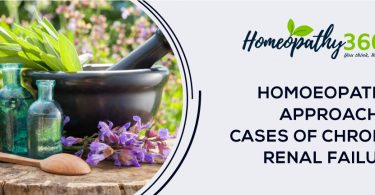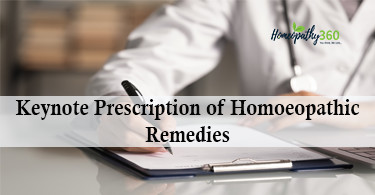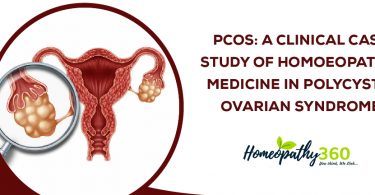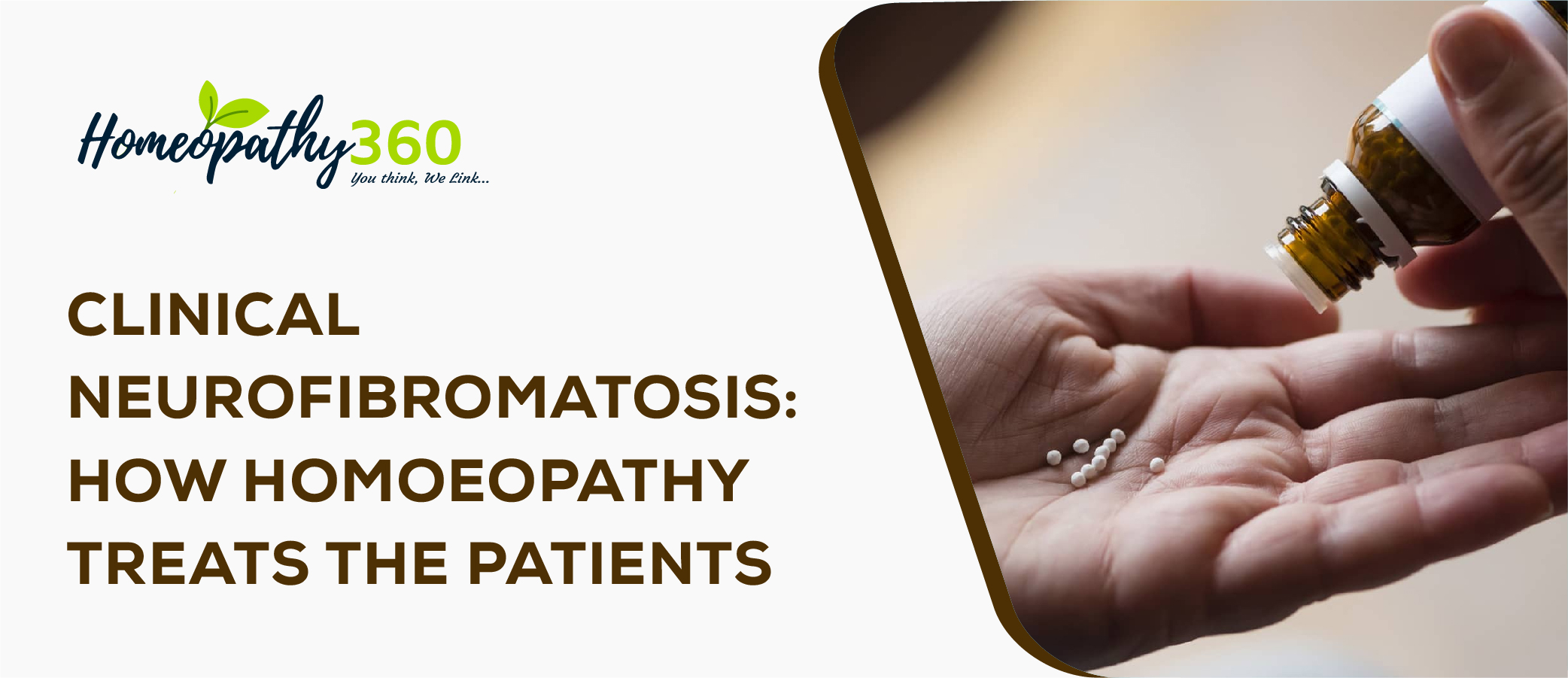
Abstract: Neurofibromatosis can be cured by constitutional prescribing in homoeopathy. The following case tries to bring out the contrast between homoeopathic prescribing and this incurable disease.
Abbreviations- NF1 – neurofibromatosis type 1, NF2 – neurofibromatosis type 2, INI1/SMARCB1 – schwannomatosis, Agg. – aggravation, ◦F- degree fahrenheit, B.P- blood pressure, mm of Hg- millimetre of mercury, QDS- 4 times a day (quater die sumendum),
Introduction
The “neurofibromatoses” are a set of distinct genetic disorders that have in common the occurrence of tumours of the nerve sheath. They include NF1, NF2, and schwannomatosis. All are dominantly inherited with a high rate of new mutation and variable expression. NF1 includes effects on multiple systems of the body. The major NF1-associated tumor is the neurofibroma. In addition, clinical manifestations include bone dysplasia, learning disabilities, and an increased risk of malignancy. NF2 includes schwannomas of multiple cranial and spinal nerves, especially the vestibular nerve, as well as other tumors such as meningiomas and ependymomas. The schwannomatosis phenotype is limited to multiple schwannomas, and usually presents with pain. The genes that underlie each of the disorders are known: NF1 for neurofibromatosis type 1, NF2 for neurofibromatosis type 2, and INI1/SMARCB1 for schwannomatosis. Genetic testing is possible to identify mutations. Insights into pathogenesis are beginning to suggest new treatment strategies, and therapeutic trials with several new forms of treatment are underway. (1)
The two types of neurofibromatosis include NF-1 and NF-2. Both cause abnormal cell growth in the central and peripheral nervous system. Each disease is inherited as an autosomal dominant trait, thus each child of an affected parent has a 50% chance of inheriting the disorder. Because there is no cure for either type of NF and treatment consists of amelioration of clinical symptoms, genetic counselling is the only preventive approach to this disease. (2)
Case study
Chief complaints
A female patient of age 30 years complained of nodular swelling all over the body with itching aggravated by warmth and sweating for 4 years.
History of present illness
Patient was in good health 4 years back when swelling suddenly appeared on left arm and gradually appeared all over the body.
Personal History
Patient had a habit of tobacco chewing.
Physical generals
Patient’s appetite was good and able to tolerate while she was hungry. She usually drank 2-3 litre water per day. Her tongue appeared moist and slightly coated. She had a desire for spicy food and aversion to onion. Perspiration was profuse on face. She was a Hot patient, as there was aggravation after warm things. Her teeth were sensitive to cold.
Mental generals
Patient seemed to be tensed and expressed her anger by shouting, consolation ameliorates her anger. Her speech was very slow and she could not concentrate on her daily routine. She was sensitive to little things, and felt even if someone was whispering in her ears during sleep.
Vitals
- Pulse- 78/minute
- B.P- 110/80 mm-Hg
Diagnosis
Diagnosis was based on clinical history and physical examination. (3)
Totality of symptoms
- Could not concentrate on her daily routine
- Slow speech
- Aversion- onion
- Agg. by warmth
- Swelling all over the body
- Perspiration- profuse on face
Analysis and evaluation of the Case
| S.No. | Symptoms type | Symptoms | Intensity |
| Mental General | Could not concentrate on her daily routine | ++ | |
| Mental General | Slow speech | ++ | |
| Physical General | Aversion- onion | ++ | |
| Physical General | Aggravation by warmth | ++ | |
| Physical General | Swelling all over the body | ++ | |
| Particular Symptoms | Perspiration- profuse on face | ++ |
Repertorial totality
Repertorisation was done with the help of Complete Repertory in HOMPATH CLASSIC 8.0.
| Symptoms | Rubrics |
| Could not concentrate on her daily routine | [C] [Mind] Concentration:difficult: |
| Slow speech | [C] [Speech & Voice] Speech:slow.: |
| Desire- spicy food | C] [Generalities] Food and drinks:onion:aversion: |
| Aggravation by warmth | [C] [Generalities] Warmth:agg.: |
| Swelling all over the body | [C] [Generalities] Swelling:general: |
| Perspiration- profuse over face | [C] [Face] Perspiration: |
Reportorial sheet (4)
Prescription
Prescribed on 10/08/2020
Thuja occidentalis LM 1,
1 drop in 100 ml aqua, 5ml of the above solution repeated 4 times in a day for 7 days.
Remedy justification
On repertorisation, remedies such as Phosphorus, Lycopodium clavatum, Thuja occidentalis, Sepia officinalis, Lachesis mutus, Mercurius solubilis, Nux vomica, Pulsatilla nigricanscame in the top.
Thuja occidentalis (5) (6) was finally selected as per the constitution of the patient as it bears an outgrowth in similar way the patient had all over the body.
Selection of dose and repetition
According to 6th edition Organon of medicine by Hahnemann in aphorism 246, it is mentioned that for 50 millesimal, frequent repetition can be done either in acute or in chronic disease. (7) So, repetition was done according to the intensity of the disease.
Follow up
| Date | Symptoms | Prescription |
| 29/08/2020 | Swelling was better Itching occasionally Concentration- better Sleep- good Thirst- moderate | Thuja occidentalis 0/1/QDS for 7 days |
Advise
Avoid tobacco
Take nutritious diet
Conclusion
Thus, it can be concluded that the method of 50 millesimal decreases the medicinal substance but increases the dynamic power to heal the patient. Finally, it may help to open the door for further research in 50 millesimal as well as in constitutional treatment in various cases of neurofibromatosis.
Before treatment
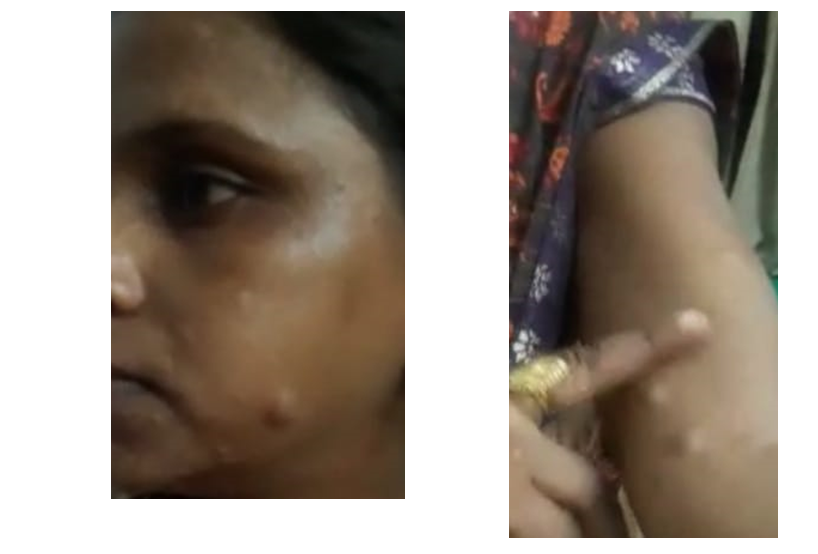
After treatment

References
x
| 1. | Korf BR. Neurofibromatosis. Handb Clin Neurol. 2013;111:333-340. doi:10.1016/B978-0-444-52891-9.00039-7.. |
| 2. | 1992 FSMNSON, doi:10.1016/0749-2081(92)90039-6 82.. |
| 3. | ICD-10. 5th ed. FRANCE: WHO; 2016. |
| 4. | HOMPATH 8.0. |
| 5. | Allen HC. Allen’s Keynote Rearranged and Classified. 10th ed. New Delhi: B. Jain Publishers Pvt. Ltd.; 2017. |
| 6. | Boericke W. Boericke’s New Manual of Homoeopathic Materia Medica and Repertory. 9th ed. New Delhi: B. Jain Pvt. Ltd.; 2014. |
| 7. | Hahnemann S. Organon of Medicine. 56th ed. Noida: B. Jain Publishers Pvt. Ltd.; 2016. |
About Author:
Dr Sarika Pandey, BHMS, MD-II scholar, Dept. Of Organon of Medicine,
Naiminath Homoeopathic Medical College Hospital and Research Centre,
Agra-283202


